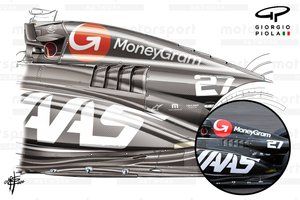Why floor designs have become a key F1 battleground
The new ground effect floor design is perhaps one of the biggest changes that Formula 1 teams have had to adapt to under the new rules era.

Photo by: Giorgio Piola
Whereas once the key to aerodynamic performance lay in wings and other aero surfaces, now more downforce as an overall percentage can be found through exploiting the underside of the car to maximum effect.
When considering the floor, we're not only talking about the visible upper surface. We also have to factor in the underfloor which, from 2022 onwards, has taken on a much more in-depth design scheme.
Previously the regulations required a flat surface on the step plane, with the diffuser section at the rear offering the ability to add vertical volume.
The new regulations allow for much more variation in the underfloor's geometry, allowing the designers to create more variation in the transition from the reference plane and in the overall shape of the floor.

Red Bull Racing RB18 floor
Photo by: Giorgio Piola
The Red Bull RB18's underfloor probably offers the most extreme example of this, with curvature to be seen across all surfaces.
It's not all about creating the maximum volume either, but rather more about controlling the flow through the 'tunnel' that's been created and the pressure distribution that inevitably creates en route.
These variables likely help in response to changes in ride height too, a considerable factor under these new regulations.
Note the sculpted finish to the transition region [1 & 2] which works alongside the floor fences, whilst a stepped boat tail section [3] gradually alters the volume from the curved tunnel portion (note the horseshoe-shaped metal section for reference in the middle of the floor) to the diffuser section.
On the outskirts of the floor, Red Bull also approached the design of its edge wing differently from others at the start of the campaign.
It opted for the 'ice skate' solution [4], which, rather than posing as a detached horizontal extension of the floor, acts as a vertical buffer. The skate provides a physical limit for that portion of the floor as ride height reduces, whilst also providing aerodynamic support for the competing flow structures funnelling into that section.


Other teams sat up and took note of some of these design traits, as seen here on the Ferrari F1-75 (left) and McLaren MCL36 (right).
They not only adopted the stepped boat tail solution [1] but also incorporated their own version of the ice skate, with Ferrari doing so early on [2], whilst McLaren tested one late on in the season.
We might have said goodbye to bargeboards from the start of 2022, but the teams do have four fences at their disposal to help improve flow, starting out ahead of the leading edge of the floor.
And, as you'd expect, we saw a wide array of design choices in this region, as each team looked to use them as a link in the floor's aerodynamic chain.


Once again we turn to Red Bull for one of the most novel interpretations, as it paired its outermost fence with one of the inner fences to help combine their effect, both out front and under the floor.
However, it did revert to a more conventional layout at the French Grand Prix, as it divorced the outer fences as part of its development push across the board.
Meanwhile, Ferrari shifted from a low-line outer fence to a much taller and longer variant during the season (dotted line, inset, shows the original height and length of its outer fence), as it also made changes to the height of its floor, with the F1-75 taking on a two-tier arrangement.


The floor's edge, which was subject to intense development throughout the last few years, was an area where teams spent significant resources during 2022, even if the regulations had seen the designers' abilities here diminished somewhat.
And, while much of that development hinged on the shape and size of the edge wing being employed, there was still some variation in the rest of the floor's shape too, with cut-outs and floor geometry introduced that would improve performance both at source and indirectly.
Be part of the Autosport community
Join the conversationShare Or Save This Story
Subscribe and access Autosport.com with your ad-blocker.
From Formula 1 to MotoGP we report straight from the paddock because we love our sport, just like you. In order to keep delivering our expert journalism, our website uses advertising. Still, we want to give you the opportunity to enjoy an ad-free and tracker-free website and to continue using your adblocker.















Top Comments